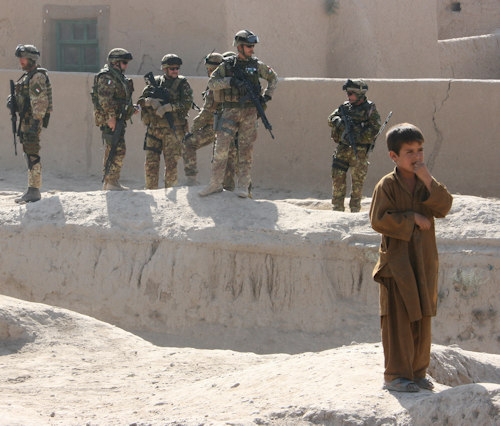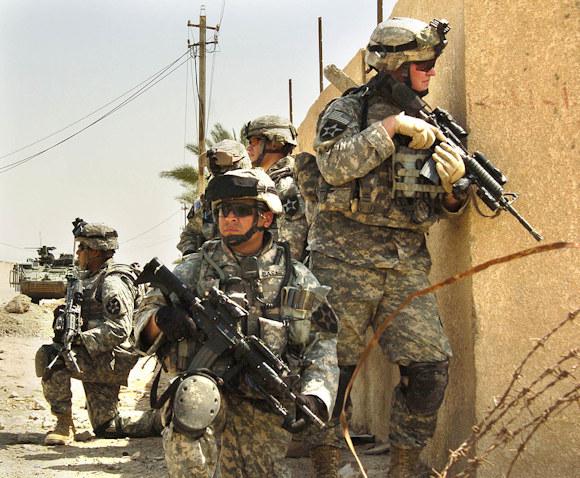On a building of the Infantry School of Cesano there is an inscription: this is the infantry weapon queen of battles. Sentence that, until a few years ago, could certainly not be questioned.
In fact, it is not necessary to remember the role of the Infantry during the First World War (the only weapon decorated with the Military Order of Savoy), in which it paid a high blood tribute.
One of the biggest navalists of the twentieth century, Admiral Fioravanzo, thus concluded his strategic considerations at the beginning of the Second World War: the infantryman will say the last word as always, unequivocally affirming any definitive conquest with his foot on the enemy ground. But its action, directly or indirectly facilitated by air and sea power, will benefit the operational possibilities of aviation and navy, to expand their action over wider horizons.
After the First World War. Infantry specialties have grown in number: paratroopers, lagoons and tankers have been added to grenadiers, bersaglieri and alpini. However, one wonders what its role is in the context of current operational scenarios.
Opinions do not always agree; as early as 2003, the IT revolution was wagered as the protagonist of battlefields; also in the same year, various articles in specialized magazines hypothesized the definitive affirmation of air power as a conflict solver. The common denominator is the affirmation of high technologies, not only in terms of effectiveness, but also to preserve human lives, as Western governments try in every way to limit losses, even among military personnel.
 This policy has induced the General Staff to use aircraft at higher altitudes, in order to remain outside the reach of surface-to-air missile systems, as well as to an increasing use of unmanned aircraft and cruise missiles, such as the Tomahawk.
This policy has induced the General Staff to use aircraft at higher altitudes, in order to remain outside the reach of surface-to-air missile systems, as well as to an increasing use of unmanned aircraft and cruise missiles, such as the Tomahawk.
On the other hand, despite technological advancement, man can never be replaced.
This was underlined at the beginning of 2003, the then Chief of Staff of the Army Lieutenant General Ottogalli, who stressed that, after the 1991 Gulf War and in light of the most recent events, the illusion of to be able to achieve zero-dead war through technology.
The intent of the chief of staff was to prevent the army from reducing itself to a role of subordination towards technology. Concepts then reaffirmed in June of the same year, or when the first phase of the war in Iraq had now ended with the conquest of Baghdad by the Anglo-American forces.
The operation against Saddam Hussein's regime marks a sort of re-evaluation of the role of the fighter. as in order to transform military victory into political victory, soldiers must be present on the ground (boots on the ground).
The war in Afghanistan, that in Iraq in 2003, as well as the most recent operations in Syria, provided a mass of technical-military teachings that could influence, not only the future organic structure of the infantry, but even more the study, aimed at 'adoption of new materials, in order to better face the new operational scenarios.
 In the particular case, the 2003 Iraq war highlighted how the Iraqi army quickly dissolved in the face of the initial advance of the Anglo-American forces.
In the particular case, the 2003 Iraq war highlighted how the Iraqi army quickly dissolved in the face of the initial advance of the Anglo-American forces.
This has highlighted, once again, an elementary truth that inevitably favors the adoption of guerrilla tactics (if not terrorist): it is not convenient for the enemies of the Western Powers to face them with the use of conventional strategies, as their superiority technological (but also maneuvering) would be overwhelming.
The second phase of the war, in fact, demonstrated the effectiveness of rudimentary tactics, such as suicide bombing attacks and ambushes with IED.
Procedures which, based on the surprise and total contempt for human life (inconceivable for us Westerners ...), make the most advanced technologies and the most modern means of fire ineffective, in fact, the American losses in the second phase of the war were greater than the first.
It is also true that, in the initial phases of the operations in Iraq, more than in hard confrontations, there have been deep advances which have required a demanding logistics job; this further reaffirmed the old need that many men, therefore, many infantry units are needed to control an area that is not completely safe, with a population that is at least partially or potentially hostile.
This situation could not be addressed with the intervention of the air force, as it requires substantial objectives in order to be truly effective; while the artillery support is not always able to be timely, as well as adhering to the operational and therefore resolutive situation.

Therefore, the West (and especially Italy) must be able to have a sufficient number of real fighters, motivated, trained, well armed and equipped: needs already felt in the wars of the twentieth century, however they have not always been met, especially regarding the events of our country.
It is also true that, the fighter who will face the new operational scenarios, must have the best instruments (material and moral) of his profession, otherwise he will not be able to operate, since nothing (firepower, technology) could make up for his possible moral and basic training deficiencies.
In our opinion, technologies must be conceived above all at the service of human safety, which must thus be put in the best conditions to fill the spaces that inevitably the aforementioned technologies leave uncovered with its action.
Combat vehicles (tanks, infantry fighting vehicles, LMVs and VTMMs) should prioritize protection, even at the expense of armament. An armored vehicle (such as the LINCE) should always have the possibility of immediately and in time identifying the surrounding threats (IEDs and kamikaze attacks), therefore of intervening without having to expose a machine gunner outside.
To say man means first of all to say infantryman.
An infantryman who cannot be left alone, since the effectiveness of his action, as well as his moral and material conditions depend on what the entire military instrument is able to put in place to support him.
It is therefore a matter of drawing all the consequences of the fact that there is no longer a front line and rear lines as was the case until the end of the Cold War.
 In today's geostrategic realities, each mission requires a careful evaluation of its characteristics, from which an appropriate application of the forces must be achieved, according to the specific case.
In today's geostrategic realities, each mission requires a careful evaluation of its characteristics, from which an appropriate application of the forces must be achieved, according to the specific case.
There is no doubt that regular armies are in great difficulty when it comes to confronting guerrilla groups (as in the case of Israeli forces in the 2006 Lebanon war), also because, in many cases, victory requires non-military actions. However, the latter remain necessary, first of all to carry out activities in favor of the civilian population, which in turn always require well-organized land departments.
Secondly, the human factor - that is, the infantryman - certainly cannot take second place with respect to technology. Future, expensive, technologies are aimed primarily at man. But it is certainly not easy to motivate western man, to instill confidence in his mission, in his weapons and in his leadership.
The most powerful army in the world, the American one, has a great need for men; this is because the technologies have and will always have insurmountable limits, moreover the conformation of the territory will always condition the conduct of the operations (as indeed happened in Afghanistan), favoring the guerrillas that can be fought effectively only with the use of light infantry (significant is the experience of the Rhodesian light infantry in the period 1966-80), which adopts the mode of action.
In conclusion, in the current strategic and tactical context, the infantry remains a multipurpose military instrument, a front-line and widely used weapon.
Photo: US Army / US Navy / Italian Army












